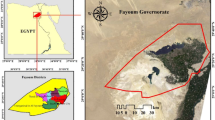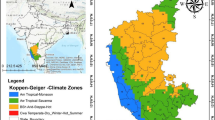Abstract
Developing approaches to automate the analysis of the massive amounts of data sent back from the Moon will generate significant benefits for the field of lunar geomorphology. In this paper, we outline an automated method for mapping lunar landforms that is based on digital terrain analysis. An iterative self-organizing (ISO) cluster unsupervised classification enables the automatic mapping of landforms via a series of input raster bands that utilize six geomorphometric parameters. These parameters divide landforms into a number of spatially extended, topographically homogeneous segments that exhibit similar terrain attributes and neighborhood properties. To illustrate the applicability of our approach, we apply it to three representative test sites on the Moon, automatically presenting our results as a thematic landform map. We also quantitatively evaluated this approach using a series of confusion matrices, achieving overall accuracies as high as 83.34% and Kappa coefficients (K) as high as 0.77. An immediate version of our algorithm can also be applied for automatically mapping large-scale lunar landforms and for the quantitative comparison of lunar surface morphologies.
Similar content being viewed by others
References
Adediran A O, Parcharidis I, Poscolieri M et al., 2004. Computer-assisted discrimination of morphological units on north-central Crete (Greece) by applying multivariate statistics to local relief gradients. Geomorphology, 58: 357–370. doi: 10.1016/j.geomorph.2003.07.024.
Bolongaro-Crevenna A, Torres-Rodriguez V, Sorani V et al., 2005. Geomorphometric analysis for characterizing landforms in Morelos State, Mexico. Geomorphology, 67(3): 407–422. doi: 10.1016/j.geomorph.2004.11.007.
Bue B D, Stepinski T F, 2006. Machine detection of Martian craters from digital topography. In: 37th Annual Lunar and Planetary Science Conference, 37: 1178.
Burrough P A, McDonnell R A, 2011. Principles of Geographical Information Systems (Vol. 19988). Oxford: Oxford University Press.
Burrough P A, Gaans P F M V, Macmillan R A, 2000. High-resolution landform classification using fuzzy k-means. Fuzzy Sets and System, 113(1): 37–52. doi: 10.1016/S0165-0114(99)00011-1.
Butle D R, Walsh S J, 1998. The application of remote sensing and geographic information systems in the study of geomorphology: An introduction. Geomorphology, 21(3): 179–181. doi: 10.1016/S0169-555X(97)00056-1.
Cohen J, 1960. A coefficient of agreement for nominal scales. Educational and Psychological Measurement, 20(1): 37–46. doi: 10.1177/001316446002000104.
Dehn M, Gärtner H, Dikau R, 2001. Principles of semantic modeling of landform structures. Computer Geoscience, 27: 1005–1010. doi: 10.1016/S0098-3004(00)00138-2.
Drăguţ L, Blaschke T, 2006. Automated classification of landform elements using object-based image analysis. Geomorphology, 81(3): 330–344. doi: 10.1016/j.geomorph.2006.04.013.
Ehlers M, Janowsky R, Gaehler M, 2002. New remote sensing concepts for environmental monitoring. In: International Society for Optics and Photonics. International Symposium on Remote Sensing, 1–12.
Florinsky I V, 1998. Accuracy of local topographic variables derived from digital elevation models. International Journal of Geographical Information Science, 12(1): 47–62. doi: 10.1080/136588198242003.
Fortezzo C M, Hare T M, 2013. Completed digital renovation of the 1:5,000,000 lunar geologic map series. Lunar and Planetary Science Conference, Vol. 44.
Gaddis L R, Skinner J A J, Hare T et al., 2006. The lunar geologic mapping program and status of Copernicus quadrangle mapping. In: 37th Annual Lunar and Planetary Science Conference, Vol. 37, p.2135.
Giles P T, Franklin S E, 1998. An automated approach to the classification of the slope units using digital data. Geomorphology, 21(3): 251–264. doi: 10.1016/S0169-555X(97)00064-0.
Guth P L, 1995. Slope and aspect calculations on gridded digital elevation models: Examples from a geomorphometric toolbox for personal computers. Zeitschrift fur Geomorphologie Supplementband, 101: 31–52.
Hengl T, Rossiter D G, 2003. Supervised landform classification to enhance and replace photo-interpretation in semi-detailed soil survey. Soil Science Society of America Journal, 67: 1810–1822. doi: 10.2136/sssaj-2003.1810.
Hodgson M E, 1998. Comparison of angles from surface slope/aspect algorithms. Cartography and Geographic Information Systems, 25(3): 173–185. doi: 10.1559/152304098782383106.
Iwahashi J, Pike R J, 2007. Automated classifications of topography from DEMs by an unsupervised nested-means algorithm and a three-part geometric signature. Geomorphology, 86: 409–440. doi: 10.1016/j.geomorph. 2006.09.012.
Jenks G F, Caspall F C, 1971. Error on choroplethic maps: Definition, measurement, reduction. Annals of the Association of American Geographers, 61(2): 217–244. doi: 10.1111/j.1467-8306.1971.tb00779.x.
Jones K H, 1998. A comparison of algorithms used to compute hill slope as a property of the DEM. Computer Geoscience, 24: 315–324. doi: 10.1016/S0098-3004(98)00032-6.
Kohonen T, 1982. Self-organized formation of topologically correct feature maps. Biological Cybernetics, 43(1): 59–69. doi: 10.1016/S0925-2312(98)00030-7.
Lewis H G, Brown M, 2001. A generalized confusion matrix for assessing area estimates from remotely sensed data. International Journal of Remote Sensing, 22(16): 3223–3235. doi: 10.1080/01431160152558332.
Miliaresis G C, 2001. Extraction of bajadas from digital elevation models and satellite imagery. Computer Geoscience, 27(10): 1157–1167. doi: 10.1016/S0098-3004(01)00032-2.
O'Callaghan J F, Mark D M, 1984. The extraction of drainage networks from digital elevation data. Computer Vision, Graphics, and Image Processing, 28(3): 323–344. doi: 10.1016/S0734-189X(84)80011-0.
Prima O D A, Echigo A, Yokoyama R et al., 2006. Supervised landform classification of Northeast Honshu from DEM-derived thematic maps. Geomorphology, 78: 373–386. doi: 10.1016/j.geomorph.2006.02.005.
Smith D E, Zuber M T, Jackson G B et al., 2010. The lunar orbiter laser altimeter investigation on the lunar reconnaissance orbiter mission. Space Science Review, 150(1–4): 209–241. doi: 10.1007/s11214-009-9512-y.
Stepinski T F, Collier M L, 2004. Extraction of Martian valley networks from digital topography. Journal of Geophysical Research, Planets, 109(E11): 179–204. doi: 10.1029/2004JE002269.
Stepinski T F, Vilalta R, 2005. Digital topography models for Martian surfaces. IEEE Geoscience and Remote Sensing Letters, 2(3): 260–264. doi: 10.1109/LGRS.2005.848509.
Tarboton D G, Bras R L, Rodriguez-Iturbe I, 1989. The analysis of river basins and channel networks using digital terrain data. Technical Report No. 326, Ralf M. Cambridge: Parsons Laboratory, MIT.
Wang J, Cheng W M, Zhou C H, 2015. A Chang’E global catalog of lunar impact craters. Planet Space Science, 112: 42–45. doi: 10.1016/j.pss.2015.04.012.
Wessel P, Smith W H, 2001. The Generic Mapping Tools. http://gmt.soest.hawaii.edu.
Acknowledgments
The LOLA DEM data and lunar geologic map used in this study were provided by the USGS. We also thank Professor Tomasz F. Stepinski for his considerable work on the recognition approach used on Mars; his contribution significantly influenced this paper.
Author information
Authors and Affiliations
Corresponding author
Additional information
Foundation: National Natural Science Foundation of China, No.41571388; National Special Basic Research Fund, No.2015FY210500
Author: Wang Jiao (1990–), PhD, specialized in planetary geomorphology and spatial analysis.
Rights and permissions
About this article
Cite this article
Wang, J., Cheng, W., Zhou, C. et al. Automatic mapping of lunar landforms using DEM-derived geomorphometric parameters. J. Geogr. Sci. 27, 1413–1427 (2017). https://doi.org/10.1007/s11442-017-1443-z
Received:
Revised:
Published:
Issue Date:
DOI: https://doi.org/10.1007/s11442-017-1443-z




